FRAMING STATEMENT
Site Specific performance instantly made me interested in how a piece of live art can be created in a space entirely inspired by its surroundings. Our performance took place in Speaker’s Corner on the High street, where we discovered at the beginning of our process that a Suffragette’s rally took place there. It was then that we had the idea to base our performance on its historical setting, which is a common stimulus of Site Specific Performance, as stated by Patrick Pavis – “a large part of the work has to do with researching place…one that is imbued with history or permeated with atmosphere”. (Pavis, 1998, p337-8) So we decided to take this on board and create a piece of live art that was based around the power of freedom of speech and protest. However we also incorporated a juxtaposition into the power of silence, and how it can affect a piece. For our actual performance our mouths were covered with duct tape to emulate our silence, as a metaphor that we are giving people the power to speak their minds.

Our performance contained one-to-one interactions which relied totally upon audience participation, as we did not communicate vocally. Each audience participation lasted approximately two minutes and their written responses were then installed into the rest of our durational performance, either in the form of placards, or they could destroy it in a paper shredder. We then planted the shreddings into the soil of the placards. The placards were in plant pots to symbolise growth and how the power of words can grow. The only communication we could offer was the instructions written on a piece of paper. This further supported our methodology as Adrian Howell writes a lot about one-to-one interactions. He also has a great interest in transactions which was another key theme of our performance. Through the transactions of written words we gave each audience participant the chance to have their voice heard or destroyed. Our main aim was for them to recognise that their voice has power and that they have the ability to have their opinions seen. The idea of growth highly influenced the aesthetics of our piece which incorporated the methodologies and took inspiration from different performance artists. The main practitioners we based our performance on were Susan Lacy who has created a lot of feminist works that focus on women’s rights. The other main artist we took inspiration from was Adrian Howell who makes performances around transaction. Other artists included the work of Dee Heddon.
PERFORMANCE PROCESS
Getting Started:
Our journey began when we first researched into Speaker’s Corner. We discovered that it was filled with history surrounding the Suffragettes Movement, because a Suffragette rally took place at the Cornhill in 1908. This allowed us to brainstorm ideas surrounding women’s rights. We knew that when the suffragette rally took place, women had no voice and little rights. We discussed the concept of time, transitions and how the site has changed over the years from a place of protest, to a place of mass consumerism. We came up with the idea of creating a performance that showed the past, present and future of the space using each of us as a representation of each. But we soon realised that we wanted to focus on the present day, as it would be more relevant and engaging to our audience. We wanted to show how even though the women’s rights movements were over a hundred years ago, their voices are still having an impact on our society today and that they are not forgotten. We wanted to almost reincarnate their message and show that there are still flaws within our society and women are still oppressed.
I researched into the Suffragettes website which shows a chronological order of events and movements. Around the time of the Rally in Lincoln, across the country many things were happening: “1909- First hunger strikes by suffragettes. Forcible feeding introduced May: Votes for Women Exhibition, Prince’s Skating Rink, Knightsbridge Formation of the National League for Opposing Women’s Suffrage. Dissolution of Parliament following battles over budget”. (The Suffragettes, no date)
Observing the Space:
We looked at the buildings that surrounded the square and instantly noticed that the shops were mainly run by big corporate companies such as: banks like Santander, Halifax, Lush, Mcdonalds. I conducted some research by going into every business in the sqaure to discover that the majority of the shop’s managers were male. This supported our ideas for women’s rights, and we toyed with the idea of creating a performance that shows that women are still oppressed and that we live in a still very patriarchal society. We then discussed the idea of basing our performance around capitalism and consumerism. We discussed how we could link it women’s rights and freedom of speech. However after much consideration, we considered that when it comes to class and capitalism, men are still just as much oppressed as women are, so we decided to create a performance that was based on men and women in society and how we are all slaves consumerism.
Situationists:
One empty building stood out to us in the square, because we thought that it reflected our capitalist society. It was a local business which was forced to close due to it not making enough profit. This really stood out against the big companies that surrounded it that make so much capital. It was then that we first looked into Situationists- the movement that believes in creating art from everyday life that goes against capitalism. They focus on how we live in a class divided world where we are distracted by consumerism. We wanted our performance to reflect this notion of every day life, and to wake people up from the capitalist trance that they are under. I took inspiration from one particular Situationist, Raoul Vaneigem. He argues how people are being drained by companies that provide them joy, and that we live under an illusion that society is fair. He highlights how we protest about the wrong thing and ignore the power of the Every Day – He states, “People who talk about revolution and class struggle without referring explicitly to everyday life, without understanding what is subversive about love and what is positive in the refusal of constraints, such people have corpses in their mouths.” (Vaneigem and Nicholson-Smith, 1994, 4) He means that people are dead to their own thoughts, because they refuse to see the truth about the capital controlled world that they live in.
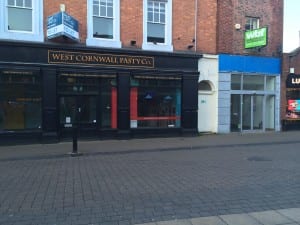
Force Feeding:
We continued research into the suffragettes in our early stages of development, to find that force feeding was a common punishment for suffragette women. The Guardian discusses the impacts the suffragette’s are still having on today’s society, and how some of their works have also been forgotten. The most striking fact was of one particular suffragette, Kitty Marion, who “was force-fed more than 232 times in prison for her beliefs.” (Lewis et al., 2016) This then prompted us into the idea of force feeding. We discussed how because we wanted it to be a silent protest and that we would be gagged. At first we thought with cloth, to stay authentic to the times of the suffragettes, however it did not seem practical as it would need to be in our mouths for a long period of time, which would get uncomfortable. So we experimented with tape instead.We took photographs with the tape took and videos of us force-feeding each other cake. The force feeding would represent the idea of society being force fed consumerism which again links into Situationists.
Transactions:
After again reviewing the physicality’s of our site, we realised that the shops were all lit up with neon lighting, big colourful logos which pointed to consumerism. This triggered the idea for transactions, which is something that takes place in the square a lot, from the banks. We discovered that neon lighting is a symbol of immediate gratification and money: arcades, cash machines and fast food. All of these things you can get quickly and easily. We then began to research practitioners who used transactions in their performances, and we discovered Adrian Howells. He “structures his performances around dual notions of “transactions” and “transformation”. His performances “tended to be performed for a single spectator at a time”(Heddon and Howells, 2011, 4). This gave us the idea to serve people in a customer type manner but a silent transaction. We discussed what type of transaction we wanted to create, and we decided that it would be the transaction of words, in exchange for us giving the participant the power to have their opinions seen.
Suzanne Lacey:
For further development ideas, we researched into Susan Lacey, whose pieces of live art often pathed the way for protest and women’s rights. She created a piece of live art that projected the sexual objectification of women and rape called From Reverence to Rape to Respect (1978) Like our performance it was a durational piece that used placards that had statements about rape on them, and women held them up along with “a media campaign including two billboards, local press coverage, and a half-hour PBS documentary, created broad community exposure to the issues of the performance”. (Early works, no date) Here, I saw the power that writing words on placards can make, as it is simple yet effective and it draws attention to the eye.
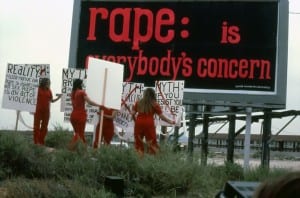
Placards:
We experimented with placards in the square, as a way of testing people’s reactions to them. We sat on the benches and watched to see if people would read them. We realised that it would look more effective if we had lots of placards filling the site, and the writing would have to be big enough for people to read from a distance.
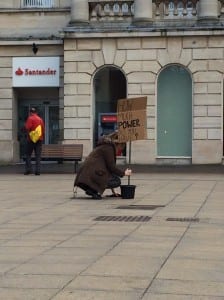
The power of Silence
After deciding that we would be silent for the duration of our piece, we researched into other performance artists who did the same. Adrian howells used silence in his piece, Foot Washing for the Sole. He used silence because he wanted to find out the question, “Is “body language” confessional?” (Howell and Heddon, 2011, 8) . We did not want to communicate our bodies, so we decided that the person (Emily B) would sit very still as a way of expressing that our role in the performance would be merely functional and symbolic. We hoped that the tape covering our mouths would indicate to the participants and audience that we were trying to give them a chance to speak.
Howell also explores silence in another one of his pieces of live art, The Garden of Adrian.
“exchange became a more solitary and internalized monologue – an exchange with/for self. I remained, though, a catalyst for the participant’s silent journey.” (Howell and Heddon, 2011, 9)
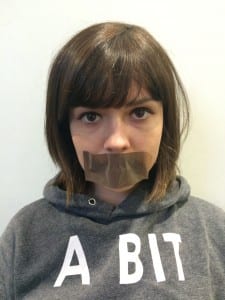
This highly relates to our final performance idea because we were catalysts for our participants, allowing them to make the art. We just provided the material. The garden in his work also links to our roots and the idea of growth.
Experimenting
Our initial idea for transactions was that we would give people free cake in exchange for them answering our question “How much power do you feel you have in society?” We would have instructions telling them what to do. So we took the idea into the space, however we did not try it in silence. We spoke to members of the public who were willing to approach us. Our idea behind this was that we wanted to get a general consensus of how the public’s opinions surrounding how much power we have in society. We created signs saying “Free cake”. We realised that the word “free” enticed people towards us as it was instant gratification which again supported our consumerism Situationist research.
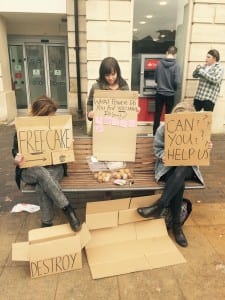
When we took our findings back to the classroom but we were told by our classmates how they thought the free cake was not necessary or essential to our piece, and it was a little distracting and took away from the overall message. We thought about giving free advice, but that did not have a strong enough to our process either. Instead we chose to give cards with a link to our blog page written on them if they wanted to find out more information. That way we still maintained our ideologies of exchange and transactions, as the participant is giving us their time and opinion, and we are giving them the power to have their voice heard or destroyed and also teaching them about the history of the site.
We came up with the idea of growth. Once the participants had answered our question, it could be planted it would be planted into the soil, their voice could grow and spread. We came up with the idea of the placards being placed in plant-pots and soil for a number of reasons. The first being that it would catch people’s attention and encourage them to read the placard. The second reason was that it gave us a function in the space and we each had a role. We could be nurturing the placard plants for the duration.
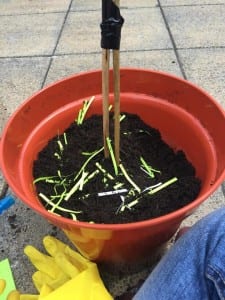
Performance Evaluation
After extensive research and practicing in the square using just soil to hold up the placards, we found that the soil was not heavy enough. Therefore we had to use sand to make sure that the placards remained stood up. Although the sand remained underneath the soil, so that the theme of growth and visual aesthetics were not ruined due to contingencies. On the day of the performance we set up 10 plant pots filled with soil, carefully placed around the square. Two wooden chairs were placed opposite each other in the centre; one for the participant and one for Emily B. Chloe’s role was to draw the roots on the ground in chalk coming out of the plant pots once a placard had been placed into it. My role was to collect the shreddings every ten minutes and to nurture the plants by adding the shreddings to the soil. This symbolises plant food and growth.
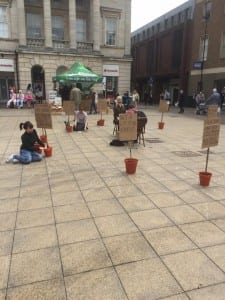
Our performance went exceptionally well. It lasted two and a half hours, although i would have liked to have done it for longer if i had the chance to perform again.This would have given more time for more participants and the placards would have looked even more effective with more written on them. Our strengths was the aesthetics of the piece; the plant-pots worked very well to signify growth and the placards were read by many people. The silence worked well because it allowed people to write their opinion and leave without feeling the pressure to explain themselves. We used the space effectively and the timings of collecting the shreddings worked well, as it looked like we always had something to do and that we really were working the ideas into the soil. Site Specific performance has taught me that you should stop and think about a place and always observe your surroundings. It has also taught me to question things about our society, and how we can use art to reflect it in a powerful way that sends a memorable message- the power is truly in our hands and voice. If we were to perform this piece of live art again, we could have had more signs saying “take a seat” to encourage more people to participate. We could have even been holding the signs ourselves.
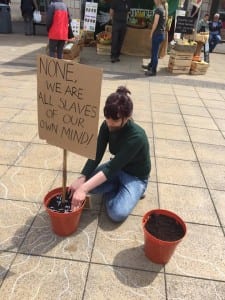
Word count: 2650
References:
Early works (no date) Available at: http://www.suzannelacy.com/early-works/#/reverence-to-rape-to-respect-1978/ [Accessed: 13 May 2016]
Heddon, D. and Howells, A. (2011) ‘From talking to silence: A confessional journey’, PAJ: A journal of Performance and Art, 33(1), pp. 8-9. doi: 10.1162/
Lewis, H., Hadley, T., Rose, J., Crompton, S., Christie, B. and Holmes, R. (2016) Why the suffragettes still matter: ‘They dared to act as the equals of men’. Available at: http://www.theguardian.com/books/2015/sep/19/suffragettes-why-still-matter-abi-morgan-film-writers-reflect [Accessed: 13 May 2016]
Pavis, P., Shantz, C., Carlson, M. and Carlson, preface by M. (1998) Dictionary of the theatre: Terms, concepts, and analysis. Toronto: University of Toronto Press.
The Suffragettes (no date) Available at: http://www.thesuffragettes.org/history/key-events/ [Accessed: 13 May 2016]
Vaneigem, R. and Nicholson-Smith, D. (1994) The Revolution of Every Life. 2nd edn. Welcombe, England: Left Bank Distribution.